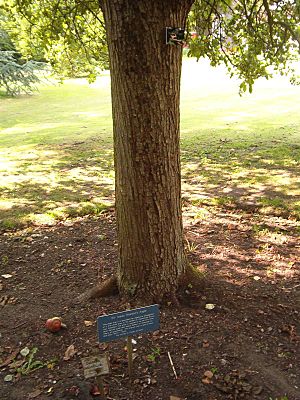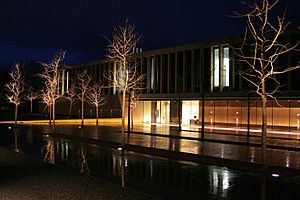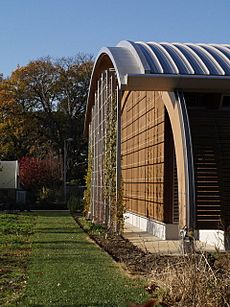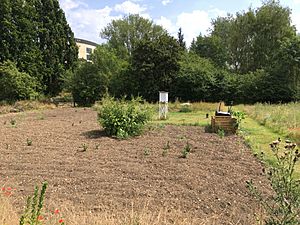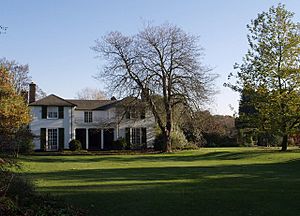Cambridge University Botanic Garden facts for kids
Quick facts for kids Cambridge University Botanic Garden |
|
|---|---|
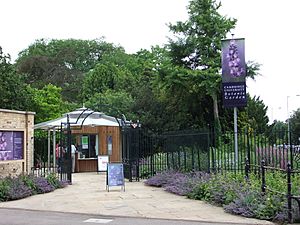
Public entrance
|
|
| Type | Botanic Garden |
| Location | Cambridge, England |
| Area | 16 hectares |
| Created | 1831 |
| Operated by | University of Cambridge |
| Visitors | 334,461 (2019) |
| Status | Open all year |
| Public transit access | Cambridge railway station |
| Director | Prof Beverley Glover |
The Cambridge University Botanic Garden is a fantastic botanical garden located in Cambridge, England. It's connected to the University of Cambridge's Department of Plant Sciences. You can find it between Trumpington Road, Bateman Street, and Hills Road.
This amazing garden covers 16 hectares (that's about 40 acres) of mostly flat land. It's not just important for science; people who love gardening also really enjoy it! The garden has over 8,000 different kinds of plants from all over the world. These plants help with teaching and research at the university. Professor John Stevens Henslow, who was Charles Darwin's teacher, created the garden for the University of Cambridge in 1831. It first opened to the public in 1846.
On July 25, 2019, the highest temperature ever recorded in the UK was measured right here in the garden: 38.7 °C (101.7 °F)!
Contents
History of the Garden
The First Garden: Walkerian Garden
After a few tries, the University Botanic Garden finally started in Cambridge between 1760 and 1763. This first garden wasn't where it is today. It was in the middle of town, on about 5 acres of land. Today, that spot is home to the New Museums Site and other university buildings.
Dr. Richard Walker from Trinity College, Cambridge bought the land for £1,600. He gave it to the University of Cambridge to be a Botanic Garden. For some years, it was known as the Walkerian Botanic Garden. Even today, there's a group called the Walkerian Society at the current garden, named after him!
Professor Thomas Martyn, who taught botany, designed and developed the Walkerian Garden. This small garden was like a traditional "physic garden." These gardens were inspired by places like the Chelsea Physic Garden in London. They grew plants used to teach medical students. They even built glasshouses and a lecture room. This helped botany teaching in Cambridge for a while.
However, this improvement didn't last long. Professor Martyn left in 1798 and only visited Cambridge sometimes until he died in 1825. Around 1790, James Donn became the Curator. In 1796, he published Hortus Cantabrigiensis. This was a list of all the plants in the garden. It was so popular that it had 13 editions!
The Current Botanic Garden
In 1825, John Stevens Henslow became the new professor of botany. He was Charles Darwin's teacher at Cambridge. Professor Henslow quickly realized that the garden needed a bigger space, further away from the town center. So, in 1831, the University bought the current 40-acre site. It's located south of the town on Trumpington Road. The very first tree was planted there in 1846.
The original plan was to use all 40 acres for the garden. But it seems there wasn't enough money. So, only 20 acres were planted, and the rest was rented out as allotments (small plots of land for growing food).
Professor Henslow, with help from a young man named Cardale Babington, planned the new garden. The land was flat and didn't seem very promising for a garden. But they designed it very cleverly! They used an old gravel pit to create a lake with a tall mound next to it. Trees and shrubs were planted in a way that showed their botanical relationships.
Glasshouses were built in the 1860s. A rock garden, one of the first of its kind in the country, was also built around the same time. The garden also became famous for its many beautiful and rare trees. By the 1870s, the main parts of the garden were finished. It was ready to help with the big growth in botany teaching and research at Cambridge.
In the early 1900s, important work on plant genetics happened here. Scientists like William Bateson, Charles Chamberlain Hurst, and Edith Rebecca Saunders did their pioneering research. Later, the garden was used for studies on how plants work (plant physiology) by Frederick Blackman and George Edward Briggs. It was also used for research on plant diseases (plant pathology) by Frederick Tom Brooks and others.
Plant Science Research
The first professor of Botany at Cambridge was Richard Bradley in 1724. Since then, many famous botanists have held this important job. Some include John Martyn and John Stevens Henslow. In 1991, the Botany School changed its name to the Department of Plant Sciences. In 2005, the title of the professor became Regius Professor of Botany.
The current Plant Sciences building was built in 1904. Back then, the main research areas were plant shapes (morphology), how plants are classified (systematics), plant diseases (pathology), and how plants function (physiology).
In 1921, H. Gilbert-Carter became the first scientific Director of the Garden. He also looked after the herbarium (a collection of dried plants). He wrote the first guide to the garden. Other directors included John Gilmour and Max Walters, who wrote a history of the garden in 1981. The current director is Beverley Glover.
The Sainsbury Laboratory Cambridge University (SLCU) is a new research center located in the garden. It's a place where scientists from different fields work together. They study how plants grow and develop. The lab uses advanced tools and computer models to understand how plants organize themselves. Lord Sainsbury funded this lab. Queen Elizabeth II opened it in April 2011. The university's herbarium also moved here in 2011.
Garden Features to Explore
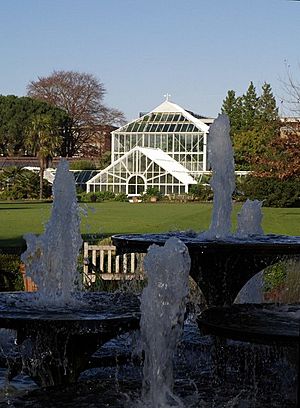
The Cambridge University Botanic Garden has many interesting areas to discover:
- Autumn colour garden: See beautiful leaf colors in the fall.
- Bed of British native plants: Learn about plants that grow naturally in Britain.
- Dry garden: Shows plants that don't need much water.
- Fen display: A special area showing wetland plants.
- Genetics garden: Explore how plant genes work.
- Glasshouses: These contain about 3,000 different plant species. They have been updated to show plants from all over the world, including:
- Continents Apart: Compares plants from South Africa and Australia, which were once joined.
- Oceanic Islands: Shows unique plants found only on islands.
- Mountains: Learn how plants survive in cold, high places.
- Tropical Rainforests: A hot, humid area full of competing plants.
- Carnivores: See amazing meat-eating plants and their traps.
- Arid Lands: Displays plants that can live in dry places, like many succulents and Cactus species. It shows how different plants can look similar when they adapt to dry conditions.
- Life Before Flowers: Full of ferns and other ancient plants.
- Herbaceous borders: Beds with many different flowering plants.
- Garden Research Plots: Areas for special projects or growing specific plant types.
- Lake: A peaceful spot in the garden.
National plant collections of:
- Important scientific and research collections of:
- Rock gardens: Perfect for alpine plants (plants that grow in rocky, mountainous areas).
- Limestone rock garden
- Sandstone rock garden
- Scented garden: Enjoy plants with wonderful smells.
- Systematic beds: 144 island beds showing 80 families of flowering plants.
- Tree collection: A wide variety of trees.
- Water garden: Plants that love water.
- Winter garden: Looks beautiful from December to April.
- Woodland garden: Home to spring bulbs and other woodland plants.
Cory Lodge and Lawn
Cory Lodge was built in 1924-25. The money for it was given to the University by Reginald Cory, who studied at Trinity College, Cambridge. It was originally where the Director of the Botanic Garden lived. Next to Cory Lodge, you can see a beautiful Catalpa speciosa tree. This Indian bean tree from North America has white flowers and long, thin fruits. On the north wall of the house, there's a Ginkgo biloba tree, also known as the Chinese maidenhair tree. It has been trained to grow flat against the wall since 1987.
See also
 In Spanish: Jardín botánico de la Universidad de Cambridge para niños
In Spanish: Jardín botánico de la Universidad de Cambridge para niños



